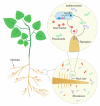Compatibility between Legumes and Rhizobia for the Establishment of a Successful Nitrogen-Fixing Symbiosis
- PMID: 29495432
- PMCID: PMC5867846
- DOI: 10.3390/genes9030125
Compatibility between Legumes and Rhizobia for the Establishment of a Successful Nitrogen-Fixing Symbiosis
Abstract
The root nodule symbiosis established between legumes and rhizobia is an exquisite biological interaction responsible for fixing a significant amount of nitrogen in terrestrial ecosystems. The success of this interaction depends on the recognition of the right partner by the plant within the richest microbial ecosystems on Earth, the soil. Recent metagenomic studies of the soil biome have revealed its complexity, which includes microorganisms that affect plant fitness and growth in a beneficial, harmful, or neutral manner. In this complex scenario, understanding the molecular mechanisms by which legumes recognize and discriminate rhizobia from pathogens, but also between distinct rhizobia species and strains that differ in their symbiotic performance, is a considerable challenge. In this work, we will review how plants are able to recognize and select symbiotic partners from a vast diversity of surrounding bacteria. We will also analyze recent advances that contribute to understand changes in plant gene expression associated with the outcome of the symbiotic interaction. These aspects of nitrogen-fixing symbiosis should contribute to translate the knowledge generated in basic laboratory research into biotechnological advances to improve the efficiency of the nitrogen-fixing symbiosis in agronomic systems.
Keywords: legume; nodulation; rhizobia; soil bacteria.
Conflict of interest statement
The authors declare no conflict of interest.
Figures



References
Publication types
LinkOut - more resources
Full Text Sources
Other Literature Sources

